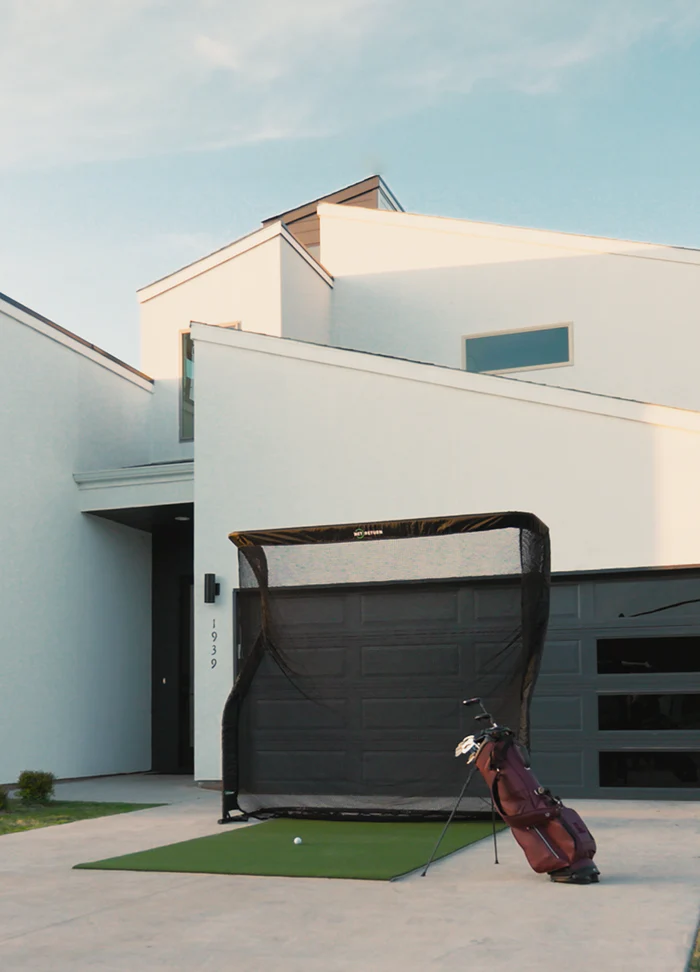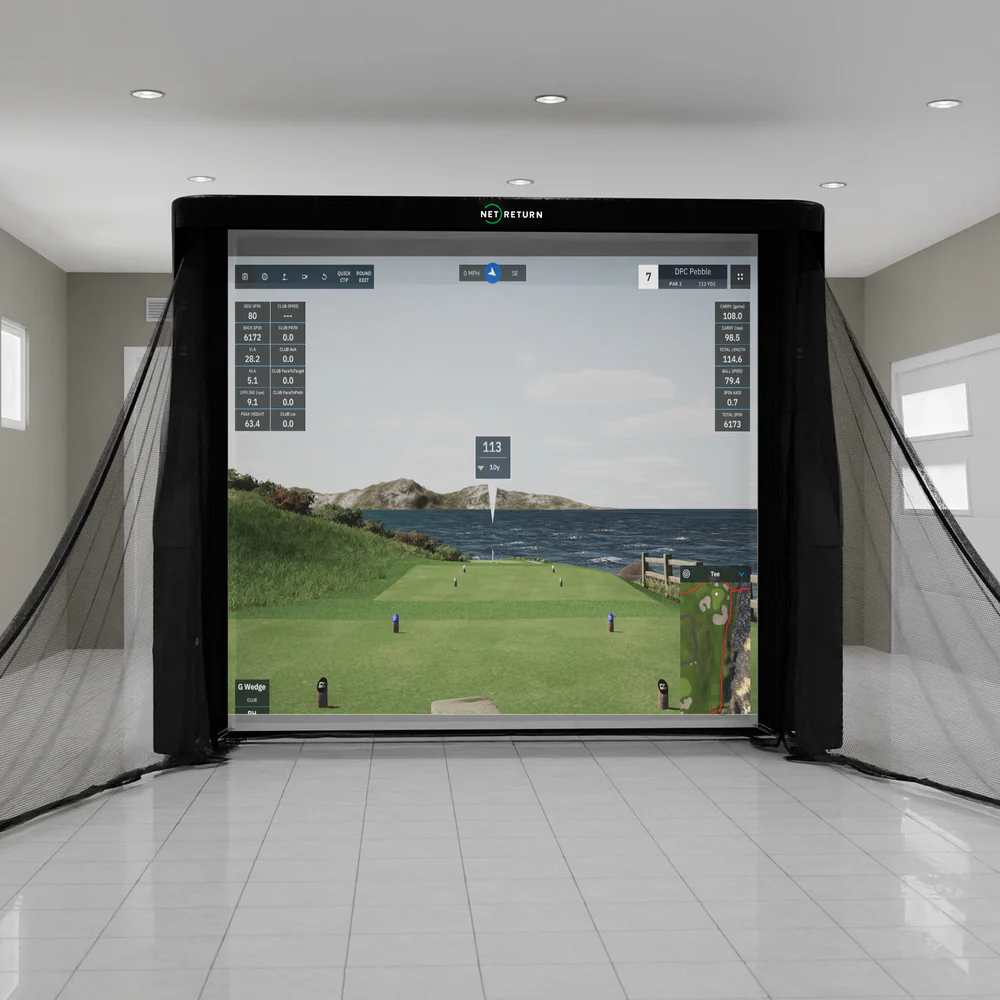Creating a home simulator bay is one of the most rewarding upgrades for any golfer or athlete—especially when space is limited. Whether you're transforming a spare bedroom, basement corner, or garage nook, designing a small-room setup requires smart planning, the right equipment, and a clear focus on safety.
We’ve helped thousands of athletes build setups that maximize performance without compromising space—or peace of mind. Let’s discuss how to build a compact simulator bay that feels professional, plays smooth, and protects everything (and everyone) around it.
Why Simulator Safety Starts with Smart Planning
The foundation of a safe setup starts well before you swing a club. Here are the three main planning factors that shape both safety and success in a small space:
1. Ceiling Height
The sweet spot for ceiling height is 9–10 feet minimum to comfortably swing a driver. In tighter rooms, consider focusing on irons and shorter clubs. Always measure your swing path fully—from backswing to follow-through—before installing any equipment.
2. Room Dimensions
For most simulator setups, a minimum of 10 feet wide by 12 feet deep is ideal. That gives you enough space for hitting, projecting, and standing safely behind the hitting zone. If your space is narrower, consider offset hitting mats or side-mounted launch monitors.
3. Clearance & Safe Zones
Keep 12–24 inches of clearance between the screen or net and the wall behind it. This reduces bounce-back and ensures the impact surface absorbs shots properly. Never place a simulator bay directly against drywall or hard surfaces without a protective barrier.
Choosing the Right Net or Screen for Small Spaces
Not all simulator enclosures are created equal—especially when you're working with tight space constraints. Here's what to look for:
Impact Protection First
Choose a high-quality impact net or screen that’s specifically rated for full-speed shots. Look for commercial-grade materials that offer both durability and flexibility. This is especially important in tight rooms where errant shots could cause damage.
Retractable or Multi-Use Nets
A retractable system can be a game-changer in small spaces, allowing you to reclaim your room when you're not practicing. Alternatively, combo systems that serve both as simulator screens and practice nets can optimize usage without added bulk.
Side Barriers Are a Must
Even seasoned players mishit shots. Side barriers, curtains, or wall pads help prevent ricochets and keep your space (and spectators) protected.
Simulator Tech That Fits Tight Layouts
Your simulator hardware should match your room—not just your swing. Here's how to choose wisely:
Compact Launch Monitors
Portable launch monitors like the Uneekor Eye Mini, Foresight GC3, or Full Swing KIT offer incredible accuracy without the need for bulky setups. Some even work from the side rather than directly behind the ball, which can help in narrow rooms.
Short-Throw Projectors
Look for projectors that can display a full image from just a few feet away. Mounting the projector on the ceiling or even the floor can save space and avoid shadows.
Flexible Hitting Mats
A center-aligned mat works best in most spaces, but for especially narrow setups, consider offset hitting positions or thinner turf that can be easily stowed.
Lighting and Room Enhancements
Avoid Overhead Shadows
Use side-mounted LED lighting or diffuse overhead lights to reduce shadows on your hitting zone and screen. Motion-activated lighting can also improve convenience in multi-use rooms.
Protect Surrounding Surfaces
Install soft paneling or fabric wall coverings to absorb impact and reduce noise. Carpeting or interlocking foam floor tiles can also help cushion dropped clubs or balls.
Ventilation Matters
Garages and basements can get stuffy—especially during longer sessions. Add a fan or small HVAC vent to keep air circulating and equipment protected.
Optimizing Every Inch of Your Room
Every square foot counts in a compact simulator setup. Consider using vertical storage racks for clubs and accessories to free up floor space, or mounting your launch monitor hardware directly to the wall. Foldable or roll-away hitting mats can help preserve usable room when not in use, making your bay a more integrated part of everyday life. We’ve even seen athletes install mirror panels or swing analyzer cameras on adjacent walls to turn small spaces into dynamic feedback zones without clutter.
Creating a Family-Friendly Practice Zone
A simulator bay isn’t just for serious practice—it can become a family-friendly hub for active fun. Foam balls, adjustable tees, and simplified games can help introduce kids to the sport in a safe, controlled environment. Just be sure to supervise younger players and enforce clear ground rules about where and when it’s safe to swing. With a few tweaks, your compact setup can serve everyone from aspiring junior players to weekend warriors.
Safety Best Practices to Keep in Mind
- Never Swing Unsupervised in Shared Spaces – Make sure others in the home know when you're practicing.
- Inspect Equipment Regularly – Worn nets, loose mounts, or damaged mats can lead to accidents.
- Use Real Balls with Caution – Foam or limited-flight balls are safer indoors, especially in ultra-compact setups.
- Create a Clear “No-Entry” Zone – Tape off or visually mark your swing zone to remind others to keep clear.
A Simulator Setup That Fits Your Life
A small room doesn’t have to limit your goals—it just demands smarter design. With the right layout, gear, and precautions, you can turn almost any room into a professional-grade practice bay that’s as safe as it is satisfying.
Ready to start your build? We’ve helped thousands of athletes—from weekend warriors to pros—create the perfect setup for their space. Whether you're just getting started or need expert help choosing gear, we’re here to guide you every step of the way.
Start Building Smarter Today
Designing a small-space simulator should feel empowering, not overwhelming. Let’s make sure your setup is safe, effective, and custom-tailored to your space. Explore our full range of pro-grade nets, screens, and accessories to build your bay with confidence.





